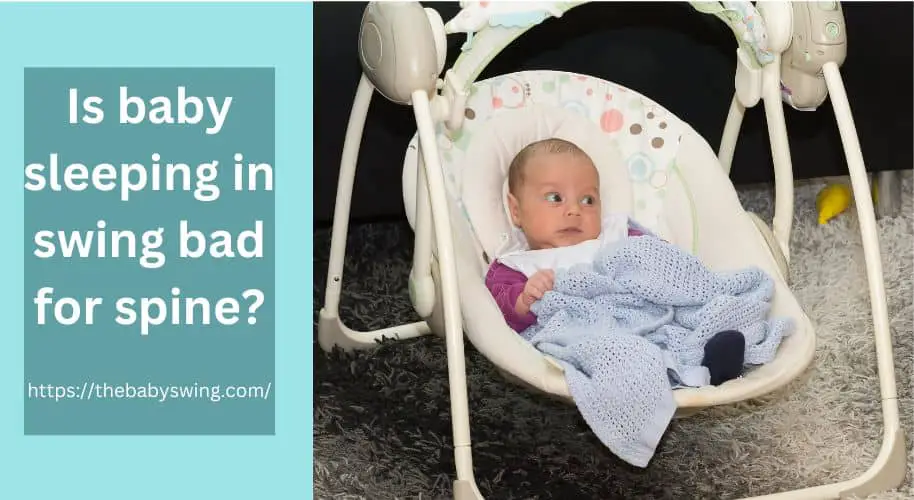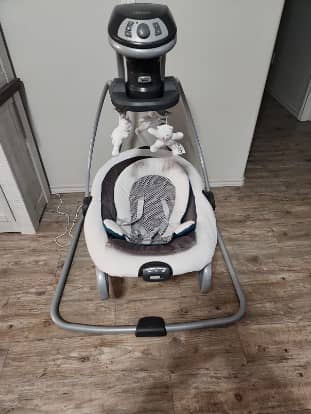Last Updated on July 18, 2023
Many parents feel that providing their baby with a swing or bouncer can help make them more comfortable and promote better sleeping habits. However, there is concern among some medical professionals about the potential harm associated with the extended use of a baby swing for overnight sleep.
Pediatricians believe prolonged use of a baby swing can affect the development of the spine and lead to poor posture, scoliosis, and other issues.
Therefore, parents should be aware of this potential risk when considering whether or not to use a baby swing for overnight sleep.
In this article, we will explore sleeping in a swing is bad for spine and why doctors are concerned. We will provide the scientific evidence that backs up their worries and look at potential ways to reduce or eliminate the risk. So, keep reading!

Is baby sleeping in swing bad for spine?
Yes, a baby sleeping in a swing for a prolonged time can be bad for the spine. Studies have shown that extended use of a rocking baby chair or bed can cause pressure on the spine, leading to poor posture and abnormal growth patterns.
This is particularly true if the baby’s body is not properly supported when in the seat, as this will allow the head and neck to fall forward and put a strain on the spine.
Additionally, the rocking motion of the swing can cause a baby to twist its upper body, which can also lead to spinal issues.
In addition, some experts have found that babies sleeping in swings for extended periods of time may be at an increased risk for Sudden Infant Death Syndrome (SIDS).
“Babies in the swing should be monitored closely and not left alone for extended periods of time.”, says Dr. Gina Jansheski, a board-certified pediatrician with over 20 years of experience. “We recommend that babies are only placed in a swing or bouncer if they are supervised at all times.”
When we asked dr. Gina, how long can a baby be in a swing? She said, “Babies should never be in a swing or bouncer for more than 30 minutes at a time, and no more than 1 hour total per day.”
She even emphasized if the baby falls asleep in a swing, it’s important to take the baby out of the swing and place them in their crib.
It’s because the baby’s spine is still developing and needs to be supported on a flat surface with the neck in a neutral position.
On the other hand, most swings are upright and the baby’s head is likely to fall forward, blocking the baby’s airway and potentially leading to SIDS.
The American Academy of Pediatrics suggests laying the baby on their back on a flat, firm surface for all sleep times.
So, sleeping in a swing is not only bad for spine development but can also increase the risk of SIDS. That’s why we suggest limiting the use of a swing and only putting the baby in it when they’re awake and supervised.
Also read: Can a baby swing cause shaken baby syndrome
Is it safe to allow baby to sleep in swing?
As stated above, the American Academy of Pediatrics does not recommend allowing babies to sleep in a swing for extended due to its potential risks. They suggest laying the baby on their back on a flat, firm surface for all sleep times.
The absence of a firm, flat surface may increase the risk of a baby rolling over and suffocating, leading to SIDS.
Additionally, the rocking motion can cause the infant’s spine to twist, potentially leading to spinal issues and poor posture over time.
Dr. Gina Jansheski also recommends being aware of the length of time a baby spends in the swing and never leaving an infant unattended in a swing.
Also read: Are baby swings bad for development
What are the Risks of Putting Your Baby to Sleep in a Swing?
Several potential risks are associated with allowing a baby to sleep in a swing. These include:
Poor Posture & Spinal Abnormalities
The rocking motion of the swing can cause the spine to twist, leading to misalignments and poor posture over time. Newborn’s neck and back muscles are still developing, so providing proper support and alignment for the spine is important.
Increased Risk of SIDS
Keeping a baby in an upright position can block the airway and increase the risk of suffocation, creating a greater chance of SIDS. AAP advises parents to lay the baby on their back on a flat, firm surface for all sleep times.
Overstimulation
Prolonged use of a swing can over stimulate your baby and affect his/her sleep patterns. This can lead to poor sleeping habits, which in turn can cause issues with mood, development, and behavior.
Stress on the Neck and Shoulders
When a baby is left in an upright swing for extended periods of time, it can cause stress to build up in their neck and shoulders. This can lead to chronic pain, difficulty sleeping, and poor posture.
Poor Weight Distribution
Too much pressure on any one area of the body from being in the same position for too long can cause poor weight distribution and interfere with proper development.
Reduced Movement
The rocking of a swing limits the baby’s ability to move around freely, which is essential for their physical and cognitive development.
Higher Risk of Choking
When babies are in an upright position, it increases the risk of choking because they are more likely to spit up or vomit. This can increase the risk of serious complications like aspiration pneumonia.
Increased Risk of Falls
Swings can be dangerous if a baby is not secured properly, as it increases the risk of falls and potential injury. It’s important to make sure your swing is secure before placing your baby in it.
Overheating
Babies have a harder time regulating their body temperature, so the risk of overheating increases when they are in a swing. This can cause severe complications like dehydration and heat exhaustion. Make sure to check the temperature of your baby’s swing often and keep it comfortable for your little one.
Anxiety
Babies can become anxious when they feel like they are stuck in one position or unable to move freely. This may lead to fussiness, making it difficult for the baby to settle down and get a good night’s sleep.
Poor Playtime
Prolonged use of a swing limits the amount of time your baby has to play and explore their environment. This can interfere with their development and impede their ability to learn new skills.
Dr. Jansheski emphasizes Parents should be aware of the potential risks associated with using a swing as a sleeping aid for their babies. A flat surface, like a crib or bassinet, should always be used as the primary sleep area for babies and a swing should only be used as a supplement or for brief periods of time.
When using a swing, make sure to follow all safety guidelines and check on your baby periodically to ensure their comfort and safety.
Also read: Baby sleeping in swing overnight
Guidelines for Safely using a baby swing

• Make sure the swing is well-secured and locked in place.
• Keep an eye on your baby when they are in the swing.
• Place them on their back in the swing.
• Make sure their airway is unrestricted when the swing is in motion.
• Make sure the harness is secure and snug around the body.
• Never use a swing as the primary sleeping area for your baby.
• Place your baby in the swing only when they are awake.
• Stop the swing when your baby is finished with it.
• Check the temperature of the swing regularly to make sure it’s comfortable for your baby.
• Make sure the fabric of the swing is not fraying or unraveling and replace any damaged parts immediately.
• If you’re using an electric swing, make sure it is plugged in properly and not near any heat sources.
• Make sure the swing is away from any furniture or sharp edges that could injure your baby if they were to fall out of the swing.
• Read and follow all safety instructions provided with the swing before using it.
• Don’t leave your baby in an upright position for longer than 30 minutes at a time.
• Check the temperature of the room and make sure it is not too hot or cold for your baby.
• Never leave an infant unattended in a swing.
Where can a baby sleep safely?
The safest place for your baby to sleep is in a crib or bassinet that meets current safety standards. Make sure the mattress is firm and there are no pillows, blankets, or toys in the bed with your baby.
Place them on their back to sleep and keep the room at a comfortable temperature. It’s also important to follow all manufacturer’s instructions when setting up your crib or bassinet.
In addition, you should regularly check the condition of your baby’s sleep area to ensure it is free from any potential hazards that could cause injury.
Also read: When to start using baby swing
What does safe sleep look like?
A safe sleep environment meets all safety standards and provides your baby with a comfortable and secure resting place. The sleeping surface should be firm and flat, covered with a fitted sheet.
The sleep environment should be free of objects or materials that may present a risk of suffocation or strangulation, such as pillows, blankets, stuffed animals, or other soft bedding items.
The temperature of the room should also be comfortable for your baby and never too hot or cold. Make sure to check on your baby periodically throughout the night to ensure their safety and comfort.
Dr. Jansheski also urge parents to be mindful of their babies’ sleep habits, ensuring that they are not in the swing for prolonged periods of time or left unattended while in the seat.
It is important to remember that a swing should never be used as a primary sleeping area for babies and it should only be used for limited periods of time. Make sure to follow all safety guidelines and check on your baby periodically while they are in the swing.
Wrapping Up
Thanks for reading! We hope this article has provided you with the information needed to understand why sleeping in a swing is bad for spine development and safety.
It’s important to note that while swings are great for providing comfort and entertainment, parents should be aware of the potential risks associated with extended use.
Be sure to monitor your baby closely when they’re in a swing and always place them on their back to sleep.
Please share this information with other parents to help them make informed decisions about their baby’s health and safety.
Sharing Is Caring!

Amy A. Vincent is a Certified Pediatric Sleep Consultant and a mother of three beautiful children. She helps parents transition their babies from swing sleep to safe, independent sleep. She is passionate about helping parents teach their children the skills needed to become good sleepers and aims to make the process as easy and stress-free as possible. Read more
